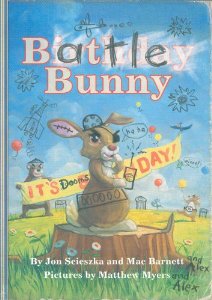Adrienne of WATAT and Jules of Seven Impossible Things Before Breakfast are having a Straight Talk About the Food Chain involving “slightly demented picture books.” Adrienne defines these as “…books that we love and that kids love that make other adults uncomfortable.”
Right up my alley! Years ago I wrote an article for Horn Book, “Pets and Other Fishy Books,” in which I considered child reaction to such wonderfully subversive books. Like Jules and Adrienne, I celebrated Jon Scieszka, Lane Smith, and Molly Leach (designer extraordinaire) for their ground-breaking book, The Stinky Cheese Man and Other Fairly Stupid Tales and went on to consider the mixed child-reactions I’d gotten from their then-latest work, Squids will be Squids. Trying to tease out why one child thought the book was hilarious (never mind what adults thought) and another didn’t I finally concluded:
Scieszka and Smith’s latest collaboration, Squids Will Be Squids, presented a new wrinkle. A send-up of Aesop’s fables, these twisted cautionary tales are all about life for a typical American kid: homework, moms, name-calling, TV, being grounded, science projects, and the like. But rising above the chuckles and requests that I read just one more was Jennifer’s plaintive voice, “I don’t get it. What’s so funny?” Stymied, I wondered, how does one explain funny? Jennifer was not amused by “Elephant and Flea,” one of the fractured fables. She and I were equally frustrated; both of us wanted her to be in on it, to join those of us who already found the book funny. Unsuccessfully, her peers tried to explain the story to her. Earnestly, they told her about the adage “elephants never forget,” pointed out the size difference between Elephant and Flea in the illustration, and referred back to the earlier fable in the book, “Elephant and Mosquito.” Of course it didn’t work. Not only can funny not be explained, but Jennifer had evidently reached her limit for dry humor.

One of my all-time favorite of this genre is Chris Raschka’s Arlene Sardine. It predates by many years, the similar Tadpole’s Promise mentioned by Jules. In the article, I describe my students’ being stymied by the book, but later groups have totally gotten it and found it roll-on-the-floor-hilarious. (Anyone who got to see Chris do his puppet show of this book was fortunate indeed.)

Another favorite (from my childhood) is the often misunderstood Struwwelpeter. It was both funny and weird to me. I always show it to my class when we reach this part in Alice in Wonderland:
It was all very well to say `Drink me,’ but the wise little Alice was not going to do that in a hurry. `No, I’ll look first,’ she said, `and see whether it’s marked “poison” or not’; for she had read several nice little histories about children who had got burnt, and eaten up by wild beasts and other unpleasant things, all because they would not remember the simple rules their friends had taught them: such as, that a red-hot poker will burn you if you hold it too long; and that if you cut your finger very deeply with a knife, it usually bleeds; and she had never forgotten that, if you drink much from a bottle marked `poison,’ it is almost certain to disagree with you, sooner or later.
I was personally most taken by Paulinchen who burned to death after playing with matches (as I was phobic about fire myself) and could tease my little sister relentlessly with poor Conrad’s story (involving thumbs and a tailor, if you don’t know it).
Finally, what about The Cat in the Hat? I guess it isn’t really a picture book, but it sure is pretty darn demented nonetheless!






